French author Francois de la Rochefoucauld said that “to eat is a necessity, but to eat intelligently is an art.”
Feeding a cat looks simple enough at first glance. You buy a bag of food with a picture of a cat on it, dump it in a bowl, and wait for your cat to eat when they’re hungry. It’s an approach that can work, but it doesn’t always bring out the best in your kitten or cat.
Feeding your cat intelligently involves a little more care.
In this cat feeding guide, you’ll learn how to nourish your cat from kittenhood through their senior years. You’ll find out how much to feed your cat at different life stages, how many meals they need per day, and which types of food are best.
We’ve broken down your cat’s dietary needs by age group, giving you a roadmap for good nutrition at every stage of life.
Your Cat’s Dietary Needs Evolve Over Time
As your cat moves through kittenhood, early adulthood, and beyond, their nutritional needs will change. Meeting those requirements at every phase of life sets the stage for good health.
Your first stop when choosing the right food for your cat? The nutritional adequacy statement.
Usually located on the back of the bag or can, this statement indicates whether or not the food is nutritionally complete and balanced for its intended life stage. The label will read, for example, “…formulated to meet the nutritional levels established by the AAFCO cat food nutrient profiles for all life stages.”
Foods that aren’t nutritionally complete and balanced will usually be labeled “for supplemental feeding only.” These foods don’t contain the appropriate balance of macronutrients (protein, fat, and carbohydrates) and micronutrients (vitamins and minerals), and shouldn’t be your cat’s sole source of nutrition.
While you’re looking at the label, check out the feeding instructions, as well. For the average house cat, the appropriate feeding instructions are usually placed on the packaging of the cat food.
The nutritional guidelines on the package will point you in the right direction, though you might need to make some modifications to fit your cat’s exact needs.
Here’s a guide on how to feed your cat during the different phases of their life.
Newborn Kitten, Age: 0 to 4 Weeks
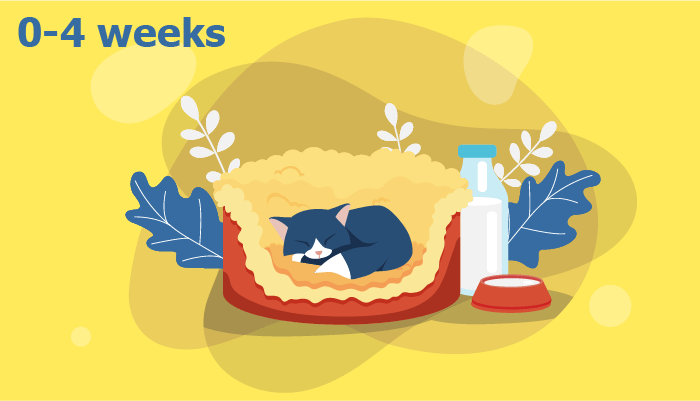
During this stage, most kittens rely on their mother’s milk as their only source of nutrition. If their mother is present, you won’t need to feed kittens at all—they’ll know how to feed themselves! That said, if you’ve rescued an orphaned kitten, you’ll need to bottle feed.
Kittens require a kitten milk replacement formula, which replicates the nutrition found in mother cat’s milk. You can purchase kitten milk replacer from your veterinarian or from a pet-supply store. Do not feed a kitten cow’s milk—it doesn’t have the right nutritional balance to nourish a newborn kitten.
Kitten milk replacer might come as a powder, which is mixed with water according to the package directions, or as a ready-to-feed liquid formula. Ready-to-feed formula does not need to be mixed up, but it’s more expensive than powder formula.
Leftover reconstituted milk replacer can be stored in the refrigerator for up to 24 hours after which time it must be discarded. Once opened, ready-to-feed liquid formula can be stored in the fridge up to 72 hours, then must be discarded. Warm up cold formula that’s been in the refrigerator before feeding it to the kitten.
How Much Should You Feed Your Newborn Kitten?
If your kitten’s mother is available to nurse, the kitten will nurse freely. If you’re bottle-feeding, follow the instructions on your package of kitten milk replacer. Exact amounts might vary depending on the brand of milk replacer, but in most cases, you’ll feed about 2 tablespoons (30 milliliters) of liquid kitten formula per 4 ounces of body weight daily.
For example, a 2-week-old kitten weighing 8 ounces would get about 4 tablespoons (60 milliliters) of liquid kitten formula daily divided into equal portions across several meals. This might look like 10 milliliters of milk replacer formula six times a day or 7.5 milliliters eight times a day.
How Often Should You Feed Your Newborn Kitten?
Newborn kittens that are nursing from their mother feed frequently, latching on to nurse once every one to two hours. However, when bottle feeding, the kittens are receiving a larger volume of formula, so they don’t need to eat this frequently. Feed kittens ages newborn to 4 weeks old every three to four hours, or six to eight times per day. Very young kittens (newborn to 1 week old) or those that seem weak can be fed every two hours.
Also Read: Best Wet Food For Kittens
4- to 8-Week-Old Kitten
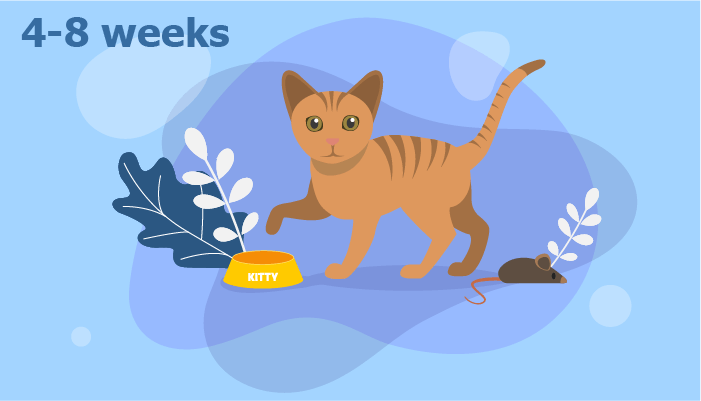
Kittens usually begin the weaning process around their fourth week. During this time, they’ll start gradually shifting from milk or formula onto a solid food diet, which delivers the protein, fatty acids, and nutrients that fuel their early development.
Also Read: The 8 Best Cat Bowls
From 4 to 5 weeks of age, bottle-fed kittens still need milk replacement formula, but you can also start slowly transitioning the kitten to a diet of watered-down kitten food. Start by replacing some of the kitten’s usual meals with a loose slurry of wet kitten food and kitten formula on a spoon. Next, gradually start feeding your kitten from a shallow saucer. Once the kitten is 5 to 6 weeks old and eating kitten food well, you can discontinue bottle feeding.
Kitten Lady has an excellent video on transitioning your kitten from kitten formula to solid food.
How Much Should You Feed Your 4- 8-Week-Old Kitten?
At this stage, your kitten is growing rapidly and needs about three times as many calories per pound as an adult. Your kitten might need 60 calories per pound of body weight. As calorie contents vary among different foods, consult the package of the kitten food you’re feeding to determine how much to feed your kitten daily.
How Often Should You Feed Your 4- 8-Week-Old Kitten?
Compared to newborn kittens that eat every one to four hours, older kittens 4 to 8 weeks old usually eat every four to six hours. Frequent meals are still essential to accommodate your kitten’s small stomach and high energy demands.
8- to 16-Week-Old Kitten
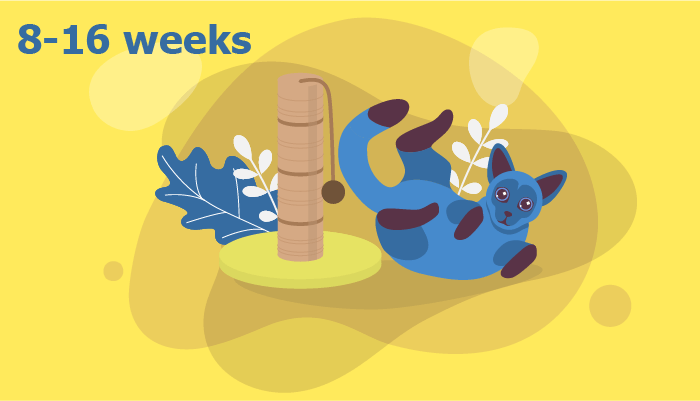
At this exciting stage of development, your kitten’s personality is developing and their predatory nature is becoming ever more apparent. By 8 to 10 weeks of age, a kitten is fully weaned and should be eating a meat-based kitten food that delivers plenty of protein, animal-derived fatty acids for brain and eye development, and the right levels of vitamins and minerals.
How Much Should You Feed Your 8- to 16-Week-Old Kitten?
During this phase, your kitten is developing rapidly and requires plenty of calories to support that growth. Growing kittens might need 250 to 280 calories per day, with larger breeds like Maine Coons and Ragdolls requiring as many as 360 calories daily. To ensure your kitten is getting enough food to meet their calorie requirements, check the label on the package of the kitten food to find out how much to feed your kitten daily.
How Often Should You Feed Your 8- to 16-Week-Old Kitten?
Three to four meals per day is ideal, but kittens older than 8 weeks can also free-feed on dry food. Be careful with free-feeding. While your kitten should be gaining weight at this stage, too much dry food can lead to excess weight gain.
Also Read: Best Kitten Food—Top 5 Best Kitten Foods on the Market Today
4- to 6-Month-Old Kitten
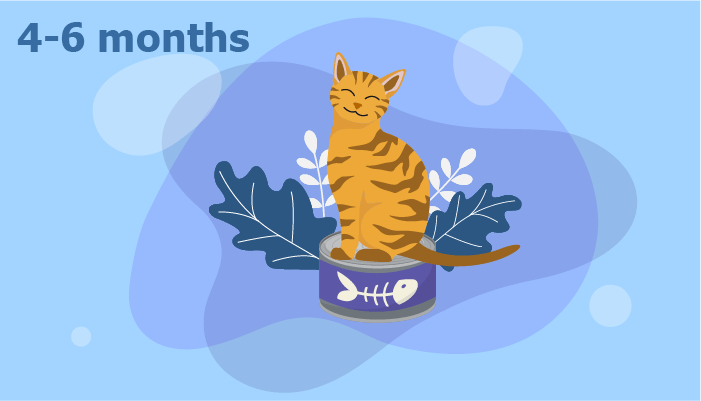
During this stage, your kitten will start to settle into their dietary routine. That’s why it’s vital to make sure you’re establishing good habits for adulthood. Feeding a varied diet can keep your kitten from becoming finicky and keep them mentally stimulated. Kittens who eat a dry diet at this stage will likely get hooked on the crunch and might not want to eat wet food later in life.
Wet or canned food is usually rich in species-appropriate animal-based protein, is lower in carbohydrates, and has a higher moisture content (70% to 80%) than that of dry food (6% to 10%).
How Much Should You Feed Your 4- to 6-Month-Old Kitten?
At this stage, kittens still need about twice as many calories per pound than adult cats. Refer to the feeding guidelines on your kitten’s food to determine how much to feed per pound of body weight.
Kittens in this age group need around 60 to 65 calories per pound of body weight per day. For example, a 5-pound kitten should consume about 325 calories per day.
How Often Should You Feed Your 4- to 6-Month-Old Kitten?
While a four-month-old kitten will need about three to four small meals per day, you can reduce daily feedings to two to three meals by the time your kitten is six months old. You can also give your kitten treats throughout the day, but calories from treats shouldn’t exceed 5% to 10% of total daily caloric intake.
6 Months to 10-Year-Old Cats
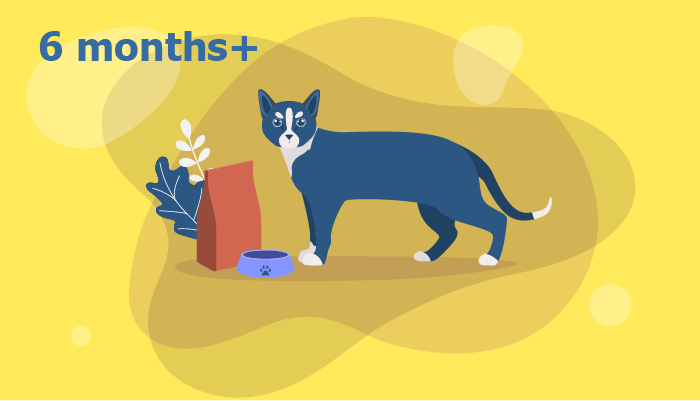
Older kittens still need plenty of calories to fuel their growth, but their metabolism will start to gradually slow down and their nutritional needs will start to look more like those of an adult.
Around the time of your kitten’s first birthday, you can start the transition from kitten food to an adult diet. Note, however, that larger-breed cats might continue to grow until they’re 3 to 4 years old and might continue to eat a growth-oriented diet. Talk to your veterinarian for advice on when to switch your large-breed kitten to an adult diet.
How Much Should You Feed Your Adult Cat?
As your kitten’s metabolism starts to slow down and they reach adulthood, you might notice them start to put on excess weight. Obesity is a common issue among adult cats and, when not corrected early on, might lead to health complications later in life. Regular exercise and a well-controlled diet will help to prevent obesity and keep your cat in good shape.
Whether you feed your cat homemade cat food or the best commercial cat foods, it’s critical to feed the right amount per day. But there’s no single amount of food that every cat should eat each day. Calorie needs vary from cat to cat, with many factors coming into play.
When deciding how much to feed your cat, you’ll have to consider their breed, age, reproductive status, underlying health conditions, and more. In general, however, the recommended daily caloric intake is about 20 calories per pound of body weight. Your vet can advise you about how much to feed your cat to maintain an ideal weight.
Click here for a calculator that helps you identify how many calories your cat needs per day.
How Often Should You Feed Your Adult Cat?
After your cat reaches 6 months of age, you may feed two to three meals per day.
Also Read: Best Cat Food Guide
Senior Years (11+ Years)
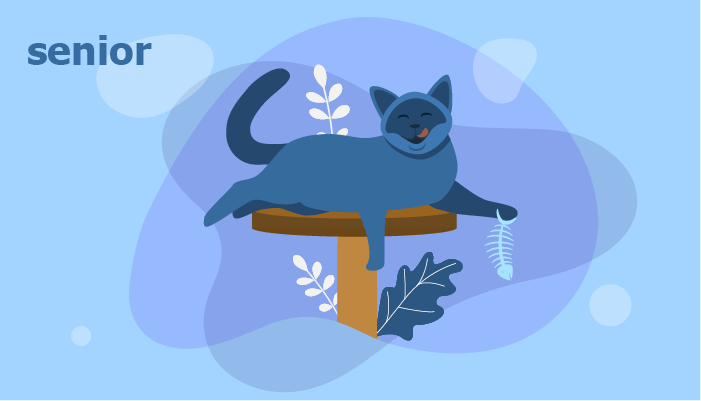
Compared to young and middle-aged adults, senior cats have unique nutritional needs. They often exhibit a reduced ability to metabolize protein and therefore tend to lose muscle mass.
Senior cats require more digestible protein to support lean muscle mass and stay healthy. Cats at this age might also develop arthritis and other inflammatory conditions, making omega-3 fatty acids a particularly beneficial addition to the senior cat’s diet.
Since older cats might have difficulty eating because of dental problems, wet or moist food is better for senior cats.
How Much Should You Feed Your Senior Cat?
Senior and elderly cats require more calories per pound of body weight. If your senior appears to be losing muscle mass, consider increasing their calorie intake to 30 to 40 calories per pound. The majority of those calories should come from animal-based protein, which helps to prevent sarcopenia (loss of muscle due to aging).
How Often Should You Feed Your Senior Cat?
Continue to feed your senior cat two to three meals per day.
Also Read: Best Cat Food For Senior Cats
Cat Feeding Chart
| Age | Approximate Weight | Amount to Feed | Schedule |
| 0 to 1 week | 50 to 150 grams (1.7 to 5.2 ounces) | 2 to 6 ml kitten formula | Every 2 hours |
| 1 to 2 weeks | 150 to 250 grams (5.2 to 8.8 ounces) | 6 to 10 ml kitten formula | Every 2 to 3 hours |
| 2 to 3 weeks | 250 to 350 grams (8.8 to 12.4 ounces) | 10 to 14 ml kitten formula | Every 3 to 4 hours |
| 3 to 4 weeks | 350 to 450 grams (12.4 to 15.9 ounces) | 14 to 18 ml kitten formula | Every 4 to 5 hours |
| 4 to 5 weeks | 450 to 550 grams (15.9 ounces to 1.1 pounds) | 18 to 22 ml kitten formula Starting the weaning process; gradually switch to a mixture of kitten formula and wet kitten food | Every 5 to 6 hours |
| 5 to 8 weeks | 550 to 850 grams (1.1 to 1.5 pounds) | Weaning; offer an unlimited amount of wet kitten food | Every 6 hours |
| 8 to 9 weeks | 1.5 to 2.6 pounds | 250 to 360 calories per day | Every 6 to 8 hours |
| 9 to 10 weeks | 1.6 to 2.9 pounds | 250 to 360 calories per day | Every 6 to 8 hours |
| 10 to 11 weeks | 1.8 to 3.1 pounds | 250 to 360 calories per day | Every 6 to 8 hours |
| 11 to 12 weeks | 2 to 3.3 pounds | 250 to 360 calories per day | Every 6 to 8 hours |
| 12 to 13 weeks | 2.2 to 4 pounds | 250 to 360 calories per day | Every 6 to 8 hours |
| 13 to 14 weeks | 3 to 4.5 pounds | 250 to 360 calories per day | Every 6 to 8 hours |
| 14 to 15 weeks | 3.5 to 5 pounds | 250 to 360 calories per day | Every 6 to 8 hours |
| 15 to 16 weeks | 4 to 5.5 pounds | 250 to 360 calories per day | Every 6 to 8 hours |
| 4 months | 4 to 5.5 pounds | 60 to 65 calories per pound of body weight per day | Every 8 hours |
| 5 months | 5.1 to 6 pounds | 60 to 65 calories per pound of body weight per day | Every 8 hours |
| 6 months | 5.5 to 6.5 pounds | 60 to 65 calories per pound of body weight per day | Every 8 to 12 hours |
| 7 months | 6 to 7 pounds | 60 to 65 calories per pound of body weight per day | Every 8 to 12 hours |
| 8 months | 6.5 to 7.5 pounds | 60 to 65 calories per pound of body weight per day | Every 8 to 12 hours |
| 9 months | 7 to 8 pounds | 60 to 65 calories per pound of body weight per day | Every 8 to 12 hours |
| 10 months | 7.5 to 8.5 pounds | 60 to 65 calories per pound of body weight per day | Every 8 to 12 hours |
| 11 months | 8 to 9 pounds | 60 to 65 calories per pound of body weight per day | Every 8 to 12 hours |
| 12 months to adulthood | 8 to 9.5 pounds | 20 to 33 calories per pound of body weight per day | Every 8 to 12 hours |
Your Cat Needs Water Too
In addition to the correct food regimen, it’s also important that a cat has access to clean water. Proper hydration helps to prevent constipation and reduces the risk of urinary system diseases like urinary tract infections and blockage.
Access to fresh water is essential, regardless of if your cat eats dry or wet food.
Consult With Your Veterinarian for More Advice
Even with the knowledge shared in this article, you should consult with your veterinarian for your cat’s individual dietary needs. Your veterinarian will be able to recommend the ideal diet and feeding regimen for your cat based on your cat’s age, lifestyle, dietary preferences, and overall health status.
-
Guide to Raising Unweaned & Underage Kittens, UC Davis Koret Shelter Medicine Program. https://www.sheltermedicine.com/library/guidebooks/?r=guide-to-raising-unweaned-underage-kittens/caring-for-kittens-from-birth-to-eight-weeks
-
https://resources.bestfriends.org/article/bottle-feeding-kittens#Feeding


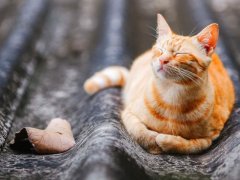

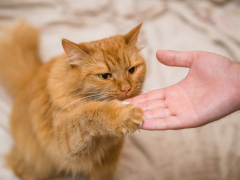



I have 2 cats. One is 4yo and other is 9 mo. The 4 yo weighs 11# and my 10 mo does too. My “kitten” is huge. I’m feeding him 5.5 oz of wet food and 1/2 C dry food every day and he still begs for more, so we give him some treats now and then. We never thought this cute tiny little kitten would grow so fast.
My 3yr old cream tabby wont eat anything but fancy feast chicken gravy and begs for some at 2am
I have a couple of quick questions about my 2 indoor only cats and haven’t been getting much, if any, good advice from their vet. But first a little background on each, they have the same mother (stray) but were born a litter apart, the female (1st litter) looks like she is Siberian and will be 7 in November of this year and the male (2nd litter) DSH turned 6 in May. The female is over weight and has never been very active, and the male is on the larger size for his breed but is very skinny. They split a can of wet food for dinner and have their dry food split between when we get up and go to sleep with eyeballed portions for each (we would prefer to make their food or only buy wet, but can’t fit either into our current budget). The female is not a jumper so we can put the male’s food where only he can reach it.
First the male can be picky about eating at times, we believe due to his stomach, he constantly has very sweet smelling liquid poops, the vet put him on probiotics that didn’t do anything to help. We’re thinking that whatever is wrong is preventing him from properly absorbing his food. He is still very active, loves to play, and cuddle, but will ask for extra food at times.
Second our female, we have cut her food intake down, but as I said she isn’t very active or playful (this was her personality even as a kitten). Beyond this we aren’t sure what we can do to help her. We live out in the country in the US where most cats are kept as outdoor “barn cats”. So not many people take their pets to the vet like we do. The only advice we can get from the vet is to buy the Hills Science Diet they sell.
My wife use to work for a holistic animal store and I worked for a large animal shelter, we both know that Purina basically wrote the books they use in US veterinary school and the vets make a lot of extra money here for selling you said low quality animal food. We have always fed our cats a high quality food with little to no fillers and don’t feel very comfortable feeding them something that isn’t as good for them and is very marked up in price.
Is there any advice beyond what we’ve gotten already you could offer? For the female taking after a larger breed of cat what should her healthy weight be (vet puts it as the same as a female DSH). Any advice would be much appreciated. Thank you.
Hi Dan, a couple of things—it sounds like your male cat might benefit from a limited ingredient diet or some sort of highly-digestible product, such as the ones on our list of the best food for cats with IBD. I suspect that a raw diet might be more digestible and help to sort out that diarrhea issue. Secondly, your female cat’s ideal weight is an individual question, and I’d recommend using our cat weight calculator to determine her ideal weight and how many calories she should be eating each day to reach it. Hope this helps. – Mallory
Hi Mallory,
I loved the read. The only comprehensive guide Ive found so far, so thank you very much!
May I only clarify one thing? In the chart, you say a 4-month old kitten should be fed 60-65 cal per their weight per day. And that you should feed them every 8 hours. Let’s say I feed my kitten 2 times a day. Do I understand correctly that I take the recommended calories intake per day and split it by 2 to get the servings right?
(Im sorry for such a questions, but Im feeding a small sphynx kitten and it just seems to finish everything, not leaving a single piece in the bowl, and is super impatient to get another serving, which made me doubt I provide it with enough calories 🙁
Thank you!
Hi Denisa, that’s right! So if your kitten weighs 4 lbs, they’ll need about 260 calories per day. That’s 130 calories per meal if you’re feeding two meals per day. Alternatively, a LOT of people prefer to free-feed kittens of this age, because they are often insatiable just as you described, and very frequent feedings are preferable to just two meals a day. At least three daily meals are recommended! If you’re feeding wet food and can’t be present to provide that many meals, you might want to set out an automatic feeder that reveals a fresh meal every few hours or put out frozen food and let it thaw over the course of the day.
Hi, I’m a bit confused by the feeding amount in this article comparing with “How much should cats eat and how often” article. I have 2 indoor british shorthairs, and they weight ~8lb and 12lb, and they are both 11 months old.
Based on the chart here, I should be feeding them at least 60 * body weight, so 480 cal and 720 cal per day.
Based on the formula in the other article: 70 * weight_in_kg ^ 0.75 * 1.3, (I picked 1.3 since they are both indoor), and I got 240 cal and 325 cal. They are half of the calories from previous calculation.
Just wondering which formula should I follow. Thanks
Hi Angelo, I see what you mean. I believe the chart was revised to correct an error at some point and things might have gotten mixed up. I’ll look into it but, in the meantime, you can use this calculator to determine the best feeding amount for your cat. It also helps you determine how much to feed based on the calorie content of the food:
https://cats.com/weight-calculator?results
i have a 18 year old a cat she is 8 pounds, i am so sed to giving her dry food all time, i am wants to giver wet food and dry food. how much should i give ?
Hello Carrie! That’s a great question. For the most accurate results, I’d recommend using our cat food and weight calculator here.
Hello i have 18 year cat she is eight pounds, i am not used to giving her wet. but i give lots of catnip and treats and fresh water and she is a indoor and outdoor at< what should i do? idk much about calories. please help me. plus its been years since. i have been to my vet is too pricey for me to go.
Hi Carrie! I would recommend checking your cat’s body composition using this tool to determine whether or not your cat is at a healthy weight. If you’d like to switch to a wet food, the first step making sure to dole out controlled portions rather than letting her free-feed on a big bowl of dry food. Serving small portions of dry food throughout the day will get your cat used to eating whatever you give her at mealtime, so it’ll be easier to start mixing in some wet food gradually. Hope this helps!
Hi,
I am very confused. I have a 4 month old kitten and I see that the amount of calories should be 30 per pound of body weight, meaning 150 calories. It says per day on the chart but the column title says “per serving”. Should I be feeding my cat 150 calories per day (total) or 150 per serving, meaning that if I feed him 3 times a day, he will be consuming 450 calories.
Could you please clarify? It would be a very different amount if I go with one rather than the other.
Hi Ana, thanks for the comment. I’ve realized that this article is mistaken in its description of kittens’ caloric needs. In reality, all growing kittens need about 60-65 calories per pound of bodyweight each day. This means that your 5-lb kitten would need between 300 and 325 calories per day. I apologize for the mistake in the article and am changing it immediately.
Hi Mallory,
My kitten just hit 6 months and noticed in the last months his eating has completely changed. He was motoring through food up until 5 months now seemingly had trouble eating the same amount of food and also ignoring more of the dry (I feed mix of dry and wet). I think he’s just going through a normal phase as he eats less due to slower growth but it’s very up and down. He was up to 300-330kcal but hasn’t progressed further even though he’s now a 6 lb cat. He’s still gaining weight readily (0.1-0.2kg a week) so I guess I shouldn’t be concerned. Energy levels seems fine. Sleeping more nowadays as he becomes more “adult like”. I’m probably more concerned with setting the right habits so he doesn’t become fussy and forces me to change foods. I used to mix the dry and wet with some water but now I feed dry with water and some wet for flavouring and then feed the wet if he eats most of the dry. Any advice or strategy on how to set good habits?
Hi there! Has your cat also recently been spayed? This will have an effect on his metabolism and, therefore, his need to eat—this might also account for some of the reduced activity you’re observing. As for ensuring that your cat maintains good habits over time, I would recommend giving your cat a varied diet of wet and dry food. Of course, prioritizing wet food is going to be the best way to ensure that your cat gets an adequate amount of moisture without too much carbohydrates. Keeping a rotation of proteins and textures is also going to be important. Hope this helps!
Hi Mallory,
he was adopted so was spayed early. I do have him on rotation between different flavours and brands so he’s been quite good with that. After he hit his peak of 330kcal he’s now down to about 270kcal so just wanted to make sure that type of drop off isn’t a concern. I’ve also recently moved him to 2 meals (+ sometimes a light snack/leftovers from breakfast). Have moved him to a larger majority wet rather than 50/50. but the wet has less calories so another reason for the drop off. I guess cat’s stomachs don’t grow that big so can really only fit in so much food each meal! Thanks for the reply!
How would u go about feeding a stray that is about 4 months old maybe. Malnourished
I perfer dry food as I work weird hours and long ones and never the same day to day and all my cats have an automatic feeder. This one is in a dog cage away from the others to get more used to me as she don’t know how to cat and my male don’t like strangers and female is freaked out by another cat (they were strays adopted at a shelter though)
She don’t like dry foods as she’s never had them and had scraps from a restaurant. She likes salmon n tuna. But how many cans should I give her per day and I’m wanting to leave dry out so she can get use to it. I’m not worried about weight as she needs good oils and good stuff in her now and so far don’t look like she over eating. I gave her a full can of tuna since she last was given salmon 14 hours ago (some was left over so dunno when she smacked)
Thanks for any tips
Oh and we can’t afford vets right now. My hubby saw her and she has an ear clipped and looks like oil burns and loosing fur from not living in the best conditions (somehow to fleas that I’ve found and don’t look like she has any ring worm (my horse had it long time ago) can’t really see anything wrong with her. Soon I’m gonna test our bond and shove a deworming pill down her throat but we’re working up on her not shying away from me when I reach for her.
Hi Dani, thank you for commenting, and apologies for the late reply! The number of cans the kitten will need depends on the calorie content of the can, but I would generally recommend putting out a can of kitten food before you leave for work, and if she’s hungry, giving her another (or two) when you get back. You can also try leaving out some dry food to allow her to nibble throughout the day.
I have a question about how to best feed my new kittens. They are spayed sisters, both 6 months old. They were previously adopted and then returned (due to unforeseeable circumstances), and then stayed with a foster, so their diet has largely been determined by the different homes they’ve bounced around in. The foster said they ate about three cans of Fancy Feast between them a day, and also left me the kibble they’re accustomed to. They also sometimes had human baby food (Gerbers chicken or beef with gravy) as a treat or food incentive with their previous owner. I really want them to have the healthiest diet possible, but they’re also used to a certain routine and are still transitioning to a new home. There are certain flavors (turkey, this morning) that they seem reluctant to eat—they also seem constantly hungry, and I’m simultaneously worried about over – and underfeeding them. For the most part my partner and I have been giving them a can in the morning and a can at night, with a small amount (let’s say 1/3 cup) of kibble for overnight, and very occasional treats. I would be more than willing to feed them more or less, or feed them better food, but I’ve also read that transitioning to higher-quality food (I bought some Wellness CORE at the suggestion of your site—if they refuse to eat it, I’ll just donate it to an animal shelter) can cause upset stomachs. Do you have any advice?
Hi Courtney, apologies for the late reply! Transitioning to a new diet may sometimes cause an upset stomach, but you can mitigate this by making a gradual transition. I think that it sounds like you’re already giving your new kittens an excellent diet, but I would definitely encourage you to try mixing in a kitten-specific food to make sure that they’re getting all of the nutrition they need to thrive. – Mallory
Hi! We just adopted 3orange tabby cats and the adoption agency fed them 2x a day – dry and wet mix. Now at 7 months old, I’m concerned they are really hungry – we’ve increased their feedings to 3x daily : breakfast at 8am – wet and dry, lunch at 2pm -wet, dinner at 8pm wet and dry mix …. is this excessive? Does the time frame work or too close together?
Hi there. I think that feeding schedule sounds just fine! As long as your cats are getting the appropriate number of calories each day and seem happy with their food, then I see no reason to change.
i feed my cats dr.elsey dry food is good cat food
Hi Ben, we think so. You can read our review of the brand here.
Dear Mallory. My question is: my cat is 13 years old and is an indoor cat. In the morning I feed 1/2 can of either Hill’s Science Diet or Authority and in the evening I feed her Dry Science Diet, 1/4 cup. Am I giving her to much and are they O.K. for her. Thank You.
Hi Hope, it really depends on your cat’s unique needs and the composition of the particular recipes you’re feeding. I’d encourage you to use this calorie needs calculator and then carefully evaluate the labels on all three of her foods. Other than that, I would encourage you to read this article about the best cat food on the market.
hello,
I have two 7 months old cats, a Scottish fold and a British shorthair from the same litter.. so far they have been eating mostly canned food, they have been suffering from gingivitis though, I am giving them a treatment now. My question, should i introduce dry food to their feeding schedule? and if so how should I divide the two and how many times should i feed them a day?
Many thanks in advance
Hello there! We generally don’t recommend dry food for cats, including those with gingivitis. Cats can be fed between 2 and 5 times per day—it really depends on your schedule and what your cats seem to enjoy. To get more ideas about giving your cats the right diet, read our article on the best cat food on the market: https://cats.com/best-cat-food
I am interested in your comment “We generally don’t recommend dry food for cats,…”
Am I not supposed to be feeding my cat kibble? She is an 11mo old F6 Savannah and she currently gets 3oz of kitten wet (1/2 in morning, 1/2 in eve) a day and 1/3 cup kibble (free fed).
I HAVE noticed lately she is not interested in her wet as much, so it may be time to start transitioning to adult food for more variety. My husband thinks it is because she eats at her kibble all day.
She does get an occasional treat or two.
Should I not be free-feeding the kibble? At all?
I would love your input
Hi Lee, you know, there is no hard-and-fast rule saying that cats must not eat any dry food. A little bit of kibble every day probably won’t harm your cat, especially if it’s a higher-protein variety. That said, a cat who eats exclusively dry food is at a higher risk of developing urinary tract issues compared to one who eats wet or a combination of wet and dry. Furthermore, dry food is typically higher in carbohydrates than wet food, which means that dry-fed kitties may have higher blood sugar and a higher risk of diabetes. So overall, it is true that I generally would not recommend dry food, but that doesn’t mean that it is entirely bad for every cat in every quantity.
That said…
A dry food addict is never a good thing. And free-feeding can cause problems. Free-fed cats don’t have the same sense of daily structure, may have issues with sleeping at night, and may be more prone to behavioral issues.
Ultimately, I would encourage you to try weaning her off of the dry food as much as possible and avoiding the free-feeding as well. While she’s still pretty young, you have a good opportunity to mold her habits and inclinations, and a diet of wet food in small, consistently-timed meals are going to be the ideal long-term. Hope this helps!
I have 2 Maine Coon cat mix..9 mos old. I feed them each one 3 oz can wet food of purina pro plan for kittens, 1/2 in am 1/2 pm and some dry food at mid day. Is that enough? They are indoor, spayed females. Im afraid of over feeding and afraid of weight issues.
Jeanne, knowing your cats’ calorie needs will help to know exactly how much they need and whether you’re giving them too much or too little. Use a calorie needs calculator and then refer to their foods’ packaging to find out how many calories they’re getting each day. Here’s the calculator: https://petnutritionalliance.org/resources/calorie-calculator/?type=cats
Hope this helps!
I have read that spayed cats’ energy requirements significantly drop with sterilization, by as much as 30%. Our 6-month-old kittens weigh in at 5.5 lbs (Riley) and 6.2 lbs (Raven), respectively. We’ve been feeding the kittens 300 cals day (each), with Riley never quite finishing her meals, but I’m thinking it’s a simple matter of her having had her fill, she being the lighter one. Well, today is Spay Day for our little girls, and I try as I may, I can’t find feeding guidelines anywhere to help us adjust a kitten’s caloric intake. All About Cats has been a great resource on so many aspects of cat life that I’m hoping you can help guide us in this matter too.
Hello there! I would recommend entering your kitties’ information into this calorie needs calculator, noting that they have been spayed: https://cats.com/cat-calorie-calculator
Hope this helps!
Hi! We have 2 short hairs. One is 6 yrs old spayed, and one 5 yr spayed. We’re trying to find a food that is complete with the full vitamins and minerals they need. Right now they eat Fancy feast 1 can a day each divided into two servings a day,, plus Purina ONe True Instinct tuna or chicken, each get 3 tablespoons each serving, they eat twice a day, We buy special vitamins because we heard the food at the stores are very minimal at best or if even fulfills the requirements they need, the vitamins are very expensive but we have noticed a difference in their bowels, their coat, and one of their temperament, She’s more calm. She used to seem more anxious. She tends to gain weight as she will eat whatever the amount you give her, I asked the vet and he said it could be mentally.!! We got her at 6 was at a shelter. She is doing so much better with the vitamins that I believe it was that the food didn’t have enough vitamins and minerals in them, Is there any decent commercial food out there? Or how do you make your own food for cats? Thanks for any help,
Hello Judy, any food that meets AAFCO requirements for your cats’ life stages should have all of the nutrients they need for optimal health. That said, since you’ve seen such an improvement in your cat’s health since you started adding the vitamins, I see no need to change what seems to be a good thing. If you’d like to upgrade to a better diet, you might try one of the foods recommended in our vet-reviewed guide to the best cat food on the market: https://cats.com/best-cat-food
Hi Judy,
Hearing your cats benefited from the vitamins, I would like to know what brand you use and how much? Thank you. Bonnie
Hi Judy,
Hearing your cats benefited from the vitamins, I would like to know what brand you use and how much? Thank you. Bonnie
I have a question, that my 3 month cat is always looks unenergetic. He is not playing, he even cant walk fast, and he really have weakness.. please replay.. sorry for bad English I cant write perfect English but please help me, what should I do. Because there is no veterinary near by me
Hello there. Unfortunately, I can’t say what may be making your kitten so sluggish. Since there aren’t any veterinarians in your area, I would recommend seeking low-cost veterinary assistance from a vet online. The Ask a Vet service from Just Answer may help you. Here’s a link: https://www.justanswer.com/sip/just-answer?r=ho|8350|link|link
Wishing you and your cat all the best.
I Have 2 Birmans, brother and sister that ar e6 years old. I give them each two 3oz cans of wet food each day with dry food left out at all times. Is that ok?
Hello Lana, thank you for asking! As long as your kitties are maintaining a healthy weight, it sounds like that should be acceptable. Of course, that type of free-feeding can lead to obesity and other health issues over time, so you’ll want to keep a close eye on their body composition and make sure that they’re not overeating in between meals.
I am a new cat owner. My cat is 5 almost 6months old. He seems to be eating quite a bit and I want to make sure I’m not overfeeding him either. I’m currently transitioning him from adult dry food to a kitten food. He gets about 3 meals a day. About 1/3cup of the adult food (400 kcalories a cup) and a little kitten food at each meal (460kcalories a cup). He has a vet appointment next week. Not sure on his weight yet, thinking at least 8lbs. He is very high energy and runs around a lot at times.
Hi Mallory- love your youtube channel- I’m having some trouble understanding the measurements- I have two 5month old boys that we are transitioning to all wet. The food I feed them is 172 a can. They each weigh five lbs. Are they supposed to get 150 calories a day or 150 calories every 8 hours? We feed them at least twice a day.
Hello Feliks! Glad to see that you made it here from the YouTube channel. I can see how that chart would be confusing—it appears to be in need of revision. A 5-month-old kitten should be taking in about 60-65 calories per pound of body weight, so the number shown is a per-feeding calorie count. You’ll want to feed your kittens about 100 calories per meal, broken into about three meals per day. Best, Mallory
My cat is around 10 years old. I give her around 50 mg of wet food in the morning and she has hard food in her dish all the time and eats it when she’s hungry. Am I giving her enough wet food?
Hello Tom, ideally a cat should be consuming significantly more wet than dry food. In other words, cats should be eating a high-moisture diet primarily composed of wet food. That said, 50g (I’m assuming that you meant grams, not milligrams—forgive me if I’m being presumptuous!) of wet food is certainly better than nothing. I’d closely monitor your cat to ensure that she doesn’t have high blood sugar or any other issues associated with eating a dry diet.
Hello! I have adopted two kittens male and female respectively and they are 7 months old.They are Persian cat,actually this is going to be my first parenting so, i do not have so much ideas about their feeding time and amount also what kind of food should i give wet or dry? Please help me
Hello Mahpara! If you can find a nutritionally-complete wet kitten food, I would opt for that rather than dry. The most important thing to consider is whether or not the food is labeled nutritionally complete and balanced for kittens. Once you’ve figured that out, the food’s packaging should tell you how much your kittens will need at each meal.
I apologize for the length of this inquiry regarding the correct amount to feed my cats. I adopted two sibling kittens at 9 weeks – the shelter would not separate them and I see why because today, at 9 months old, they are still very close. They still use the same litter box. Even though I have two litter boxes, they don’t use the second. They also eat from a dual bowl at the same time and still can be found cuddling and licking each other, although not as frequently as when they were young. They have completely different personalities though – he’s bold and inquisitive and has always been a talker; she’s easily frightened of strangers but loves to play.
The female now weighs 8.3 pounds and I think the male is close to 10 pounds (he won’t let me pick him up — he’s a pretty big cat). They were both neutered/spayed before I brought them home.
Now, since they are fed together, I am not sure how much to give them. They share a can of Fancy Feast at about 6:30 am, another at 12:30 pm and another at about 6 pm. They seem to be hungry again before we go to sleep so I’ve been adding another can at about 10 pm, which I think is wrong. The female eats a little less than the male and she is also pickier. She’s also more active.
The total daily caloric intake for the two iis about 400 calories, with him eating a bit more than half (maybe 220 and 180 respectively.) They eat very little kibble — about a tablespoon each per day. And they always have fresh water but don’t drink a lot.
Please let me know if I should make some changes. Thank you.
Hello Lee, thanks for the message! You’re clearly a very conscientious cat guardian, so please don’t apologize for the length of your inquiry! Since both of your cats are still kittens, I don’t see anything wrong with the four meals per day. That said, the additional kibble may be excessive, even though it’s only about a tablespoon. You might replace the kibble with an occasional treat. Otherwise, as long as your two kitties have a healthy body composition (hourglass shape when viewed from above, ribs palpable, a thin coating of fat on the abdomen), I see nothing wrong with their current diet. It sounds like you two kitties have a wonderful relationship and a very happy life. Keep up the good work!
i like this
My two ginger cats are totally different even though they are both from the same litter, one of them I’m assuming he is the eldest has tried to become the dominant one, he still try’s actually, that’s not only with my cats but with me also. He can be very loving when he wants to be,but also quite aggressive, my arms legs hands and feet can testify to this, both cats are also very greedy,they steal food,not only from my other cats but from my plate and even my shopping bag. I have five cats now,and they all have one full sachet of wet food at least 3times each day. There is also a large dish of biscuits always there for them, I have two water fountains for them indoors, and a large bowl of water outside when they are in the catio. There is also the fact that my three strays all hate being in the catio,and keep on finding ways to escape. Am I being cruel expecting to be as happy being there as my two pedigree. All my cats have been neutered